Reading time is around minutes.
Section 1 Subsystems -
Memory -
Memory performance is very important on a motherboard, especially when you have a CPU with multiple cores and threads. If you have slow memory your cores and threads can become starved for data to execute. To test memory performance we run both Sisoft’s SANDRA and AIDA64. These two combine to not only give us accurate numbers but to validate each other. For testing at stock speeds the memory is hard set to 1600MHz while overclocking testing is done at the highest stable speed for the voltage of 1.65v this is due to the different memory dividers for each CPU. As such, the memory speeds will vary greatly. This means that the overclocked numbers are a little misleading and while they can show a trend are really only included to show if a board has a problem with memory performance at high clockspeeds.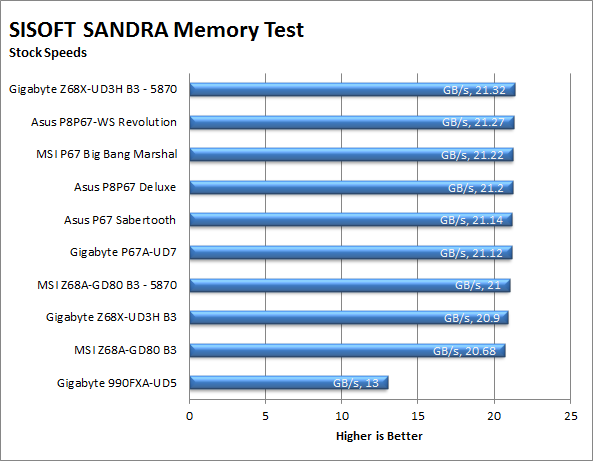
The memory performance on the Gigabyte Z69X-UD3H is right where it should be (around 20-21GB/s). This is good for those that are looking for solid and stable performance for everything from general purpose usage to gaming. 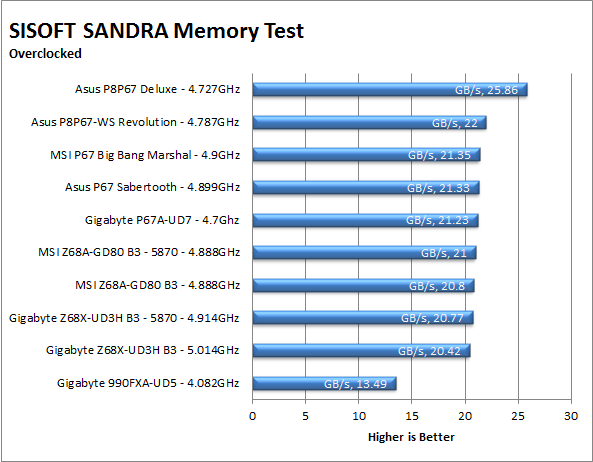
AIDA64 shows us what helps to elevate this memory performance to the level it is at. Intel’s caching structure helps to keep the CPU running efficiently and overcomes some of the inherent latency found when you put a memory controller inside the CPU.
| AIDA64 Memory Performance CPU Only | AIDA64 Memory Performance w/HD587 |
 |
 |
Drive performance -
Drive performance is also one of the major subsystems that goes to make up the performance of a motherboard. For our testing we use Sandra and AIDA64 again. We only test with single drives for each type of controller present on the motherboard (unless it is a professional product where we will use RIAD 5 and/or 10). We have also begun using a Seagate PS-110 USB 3 external HDD for our USB 3.0 performance. As a side note, we include the overclocked numbers here to make sure (again) that you are not going to see a major drop in performance due to minor instabilities at high clock speeds.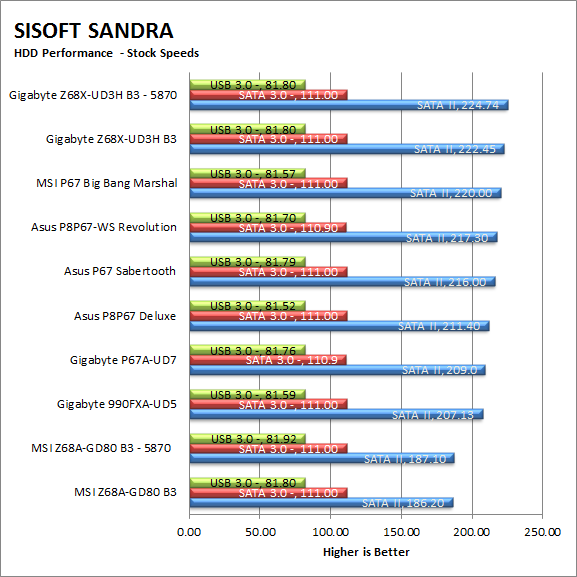
For drive performance the Z68X tops out our scale (at least for SATA 2.0). When you combine this with the solid memory performance we should see some good numbers when we get our main battery of tests going. 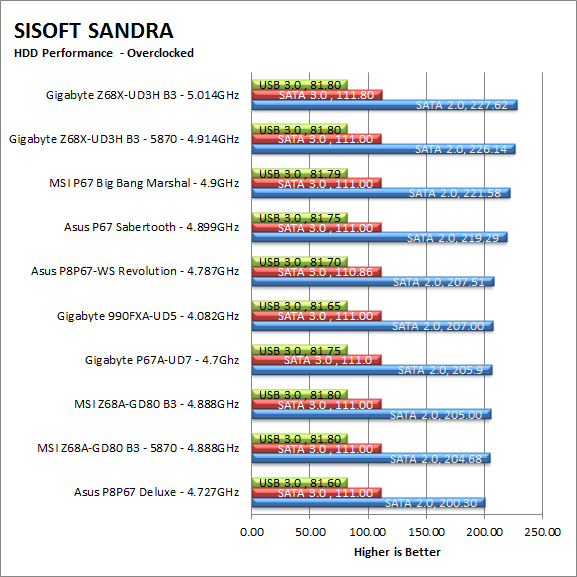
AIDA64 backs up the numbers from SANDRA. Solid memory performance and excellent drive speeds are a good combination to have.
| AIDA64 HDD Performance CPU Only | AIDA64 HDD Performance w/ HD5870 |
 |
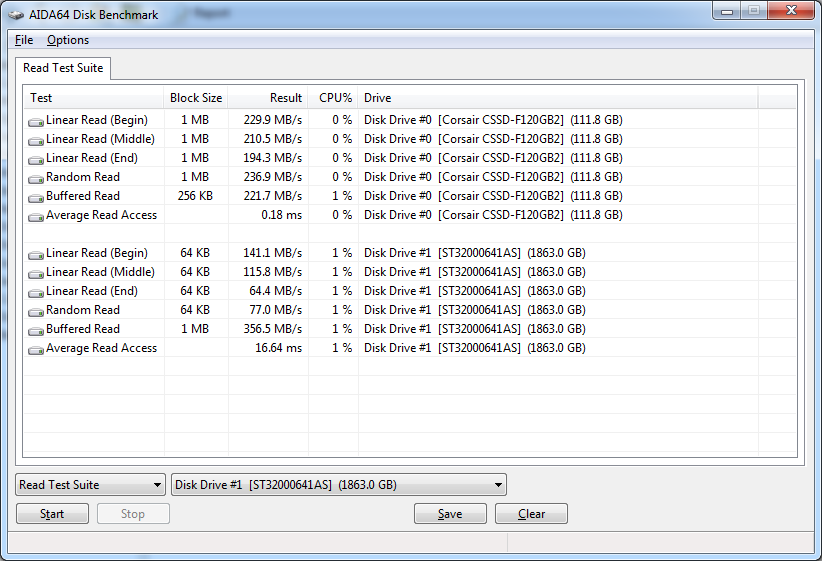 |
| AIDA64 USB 3.0 Performance CPU Only | AIDA64 USB 3.0 Performance w/ HD5870 |
 |
 |
Power -
Power efficiency is another of those misnomers that we get caught up in. We hear about idle states and power gates. But what does that mean to you and I? On the surface having power management that reduces idle power sounds great and can be a benefit to someone that leaves their system on for long periods of time (and inactive) but how a system handles power under load and the delta between the two states is often more important than the idle power usage numbers. We use only P3 Kill A Watt instruments for measuring power. 
Now this is extremely impressive! The Gigabyte Z68X-UD3H has the lowest power draw out of all the boards we have tested to date. Even overclocked the board does well in comparison to other boards in the same range. 
Cooling (Board Level) -
Board level cooling is an important factor in product performance and longevity. Components like the chipset, VRM modules and even capacitors need to be kept relatively cool to prevent failure. As these parts are made of silicon, they have a thermal breakdown threshold; or melting point. At that temperature the actual transistors built into chip will begin to deform and break down. Granted, the threshold is often very high, but you still need to make sure that components stay away from this level of heat for longer product life. 
The cooling on the Z68X is pretty good. It is using the new style of heatsink that Gigabyte has put on their 2011 products. It has a great look to is and it is also fairly efficient. We have found that it does not work for every occasion (it can get saturated quickly). If you do not have good air flow across it you tend to get higher temperatures than you would with other solutions. 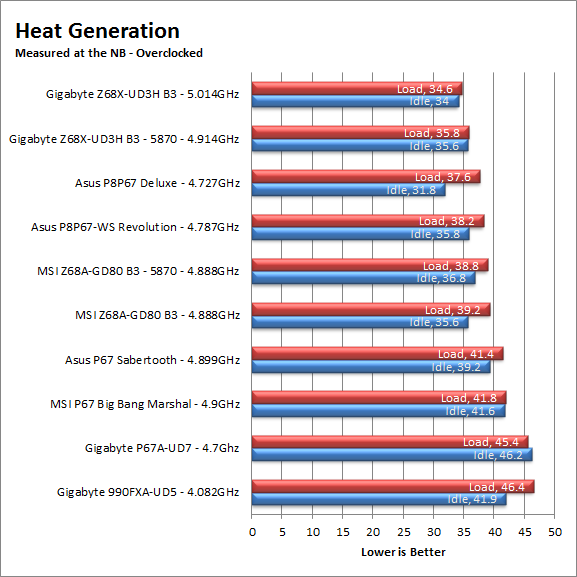
Audio -
Audio is highly subjective. What we find pleasing may sound “off” to you. That is always going to the problem with testing audio; results will vary too widely depending on the tastes of the listener. However, there are ways of measuring the audio output with an objective ear. There is also the issue of audio causing performance issues in gaming and video playback. The reason this is a potential source of concern is that all onboard audio CODECs (Compression/Decompression) are CPU controlled. This means that while the audio chip controls the audio levels and effects of the audio the actual work is done on the CPU. Usually this will not be a problem with today’s powerful CPUs. Even the lower and consumer level products can handle high-end audio these days. But again there is the chance that a bad design or software will hinder your system and performance. On the other side the limits of board space, cost, etc will also prevent the level of audio quality you can get from an add-in board. We test all audio parts with three media types, Movie (DVD), MP3 Music, and Gaming. These are pushed to our Tec On model 55 Tube Amp to see if we can detect any signal issues in the reproduction.
As Gigabyte is improving their products for enthusiasts they are also working to improve the overall user experience. To do this they have moved adding in audio CODECs that support higher Signal to Noise ratios as well as other advanced audio features. When we tested this we found that the audio reproduction was very good. It is not audiophile quality, but it is still good. We did not notice anything until we went to our Tube Amp and to be honest with you, if you are planning to use a Tube Amp you will want to drop in an Add-in audio card anyway.
Networking -
This one is something that is a requirement anymore. If you have a computer, the chances are good (like 99%) that you are also connected to high-speed internet. With this you need a good and solid LAN chip to make sure that your data flows properly out and back.
The networking performance was also very solid. Again you are not going to win any speed awards, but you can certainly get your data back and forth across the network and the internet. Then again, when you consider than even the fastest residential internet connection right now is not over 100MB/s you do have plenty of headroom to play around with.
